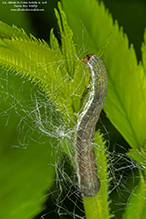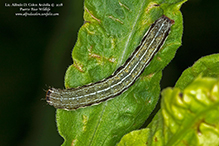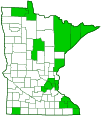Norman’s quaker
(Crocigrapha normani)
Conservation • Description • Habitat • Ecology • Distribution • Taxonomy
| Hodges # | 10501 |
||
Conservation Status |
|||
| IUCN Red List | not listed |
||
| NatureServe | NNR - Unranked |
||
| Minnesota | not listed |
||
Description |
Norman’s quaker is an early season, medium-sized owlet moth. It occurs in North America from Quebec to Alberta south to Georgia and Colorado. It is most common in New England and in the Midwest. It is common in Minnesota. Adults are found from April to June. Mature larvae (caterpillars) are found from late April to July on the leaves of many species of deciduous trees, including apple, ash, aspen, birch, cherry, elm, ironwood, maple, oak, plum, and willow; and shrubs including blueberry, hazel, rose, and witch hazel. Adults are 11 ⁄16″ to ¾″ (18 to 19 mm) long and have a wingspan of 1 5 ⁄16″ to 1 9 ⁄16″ (33 to 40 mm). The forewings are long. The rear (outer) margin is strongly angled inward from at or near the leading (costal) margin to the inner margin. The ground color is variable, usually dark brown but sometimes reddish-brown, orangish-brown, yellowish-brown, or brownish-gray. There is a large whitish patch at the outer angle, where the costal margin meets the outer margin. The antemedial (AM) line is smooth, slightly curved, and pale in the center with thin dark border above and a broader dark border below. The postmedial (PM) line is strongly curved downward in the middle and upward approaching the inner and costal margins. It is pale in the center with broad dark border above and a thin dark border below. The median area, between the AM and PM lines, is often darker than the ground color. On light individuals, there is no subterminal (ST) line. On dark individuals the ST line is defined by the paler terminal area and the darker subterminal area. The terminal line consists of a line of black dots, one at the end of each cell. There is a circular spot (orbicular spot) in the upper median area and a kidney-shaped spot (reniform spot) at the end of the discal cell. Both spots are bordered with white and are the same color as the ground in the center. The reniform spot has a conspicuous black spot in the inner half. The hindwings are whitish at the base, gradually darkening approaching the outer margin. The head and thorax are the same color as the forewings. On the upper side of the thorax there is a tuft of hairs that is inconspicuously divided into a small tuft in front and a large one in the rear. The antennae are threadlike on both the male and the female. The caterpillar is called climbing cherry cutworm. Late stage (instar) caterpillars are about 1⅜″ long and reddish-brown to tannish-brown. They have no stripes and few other distinguishing features. The breathing pores (spiracles) are brown rimmed with black. Sometimes there is a barely distinguishable pale stripe through the spiracular area. The plate on the upper side of the first segment of the thorax (prothoracic shield) is dark brown and shiny above, pale on the sides, and has a pale spot in the middle at the rear. The eighth abdominal segment is somewhat humped and has a pale horizontal line at the rear. The head is brown and shiny, with two dark spots on each side that merge together. Middle and second-to-last (penultimate) instar caterpillars are sharply bi-colored, dark olive green above and creamy white below. The subspiracular area is the darkest. There is a thin longitudinal stripe in the middle (middorsal) and a thin white stripe on each side in the subdorsal area. The head has two dark spots on each side that do not merge together. |
Size |
Total length: 11 ⁄16″ to ¾″ (18 to 19 mm) Wingspan: 1 5 ⁄16″ to 1 9 ⁄16″ (33 to 40 mm) |
Similar Species |
Habitat |
Forests, woodlands, and large gardens |
Ecology |
Season |
One generation per year: April to June |
Behavior |
Adults are active at night and will come to lights. |
Life Cycle |
Females lay large, tight clusters (rafts) of eggs on the leaves of host plants. The pupa overwinters. |
Larva Hosts |
Leaves of deciduous trees, including apple, ash, aspen, birch, cherry, elm, ironwood, maple, oak, plum, and willow; and shrubs including blueberry, hazel, rose, and witch hazel. |
Adult Food |
|
Distribution |
||
|
Sources 21, 24, 29, 30, 71, 75, 82, 83. Biodiversity occurrence data published by: Minnesota Biodiversity Atlas (accessed through the Minnesota Biodiversity Atlas Portal, bellatlas.umn.edu, 9/1/2025). |
|
| 9/1/2025 | ||
Occurrence |
||
|
||
Taxonomy |
|
Order |
|
Superfamily |
Noctuoidea (Owlet Moths and Allies) |
Family |
Noctuidae (cutworm moths and allies) |
Subfamily |
|
Tribe |
Orthosiini |
Genus |
Crocigrapha |
Subordinate Taxa |
|
|
|
Synonyms |
|
Perigrapha normani |
|
Common Names |
|
climbing cherry cutworm (caterpillar) Norman’s quaker |
|
Glossary
Antemedial (AM) line
A thin line separating the basal area and the median area of the forewing of Lepidoptera.
Costal margin
The leading edge of the forewing of insects.
Instar
The developmental stage of arthropods between each molt; in insects, the developmental stage of the larvae or nymph.
Orbicular spot
A circular spot or outline in the upper median area near the antemedial line on the forewing of many moths.
Postmedial (PM) line
A thin line separating the median area and the postmedial area of the forewing of Lepidoptera.
Reniform spot
A kidney-shaped spot or outline in the lower median area near the PM line on the forewing of many moths.
Spiracle
A small opening on the surface of an insect or arachnid through which it breathes.
Visitor Photos |
Share your photo of this insect. |
||
This button not working for you? |
||
Alfredo Colon |
||
 |
 |
|
MinnesotaSeasons.com Photos |
|

Slideshows |
Noctuidae - Crocigrapha normani |
About
Xxxxxxxxxxxx |

Visitor Videos |
Share your video of this insect. |
||
This button not working for you? |
||
|
Other Videos |
|

Visitor Sightings |
Report a sighting of this insect. |
||
This button not working for you? |
||
MinnesotaSeasons.com Sightings |
|

|
Created: 12/13/2019 Last Updated: © MinnesotaSeasons.com. All rights reserved. |


